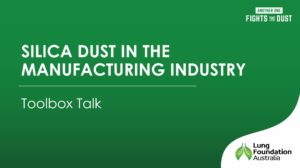This toolbox talk developed by Lung Foundation Australia is for employers, PCBUs and other supervisors to deliver to workers in the manufacturing industry. The toolbox talk focuses on silica dust in the manufacturing industry and how to reduce exposure. This toolbox talk is in a PowerPoint presentation format and includes speaking notes to help guide the presentation and facilitate discussion. To access the speaking notes along with the slides, please download the resource. This toolbox talk was developed as part of the National Silicosis Prevention and Awareness Campaign that Lung Foundation Australia run on an annual basis.
Silica dust is a hazardous substance found in materials like soil, sand, granite, and engineered stone. When these materials are cut, drilled, or disturbed, they release fine silica particles into the air, posing serious health risks to workers. This resource from the Lung Foundation Australia provides essential information on silica dust and how to minimize exposure in the mining and quarrying industry.
Sources of Silica Dust
Silica dust is generated during various mining and quarrying activities, because it occurs naturally in the earth’s crust. It can be found in most rock, limestone and sandstone.
Health Risks of Silica Dust
Inhaling silica dust can lead to severe health conditions such as:
- Silicosis
- Lung Cancer
- Chronic Obstructive Pulmonary Disease (COPD)
- Other Conditions: Including rheumatoid arthritis, chronic kidney disease and autoimmune conditions
Preventing Silica Dust Exposure
- To protect workers from silica dust, the resource emphasizes the Hierarchy of Controls:
- Elimination: Remove the hazard entirely
- Substitution: Use safer alternatives
- Isolation: Separate people from the hazard
- Engineering Controls: Redesigning or modifying equipment
- Administrative Controls: Implementing training and procedures
- Personal Protective Equipment (PPE): Use fit for purpose PPE
For more detailed information, visit the Lung Foundation Australia website.
Was this page helpful?
Good job! Please give your positive feedback
How could we improve this post? Please Help us.




